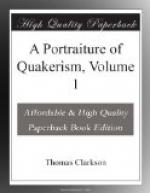The other remarkable circumstance is, that there is no ostensible president or [30] head of this great assembly, nor any ostensible president or head of any one of its committees; and yet the business of the society is conducted in as orderly a manner, as it is possible to be among any body of men, where the number is so great, and where every individual has a right to speak.
[Footnote 30: Christ is supposed by the Quakers to be the head, under whose guidance all their deliberations ought to take place.]
The state of the society having, by this time been ascertained, both in the meetings of the women and of the men, from the written answers of the different deputies, and from the reports of different committees, and the [31]other business of the meeting having been nearly finished, a committee, which had been previously chosen, meet to draw up a public letter.
[Footnote 31: This may relate to the printing of books, to testimonies concerning deceased ministers, addresses to the king, if thought necessary, and the like.]
This letter usually comprehends three subjects: first, the state of the society, in which the sufferings for tithes and other demands of the church are included. This state, in all its different branches, the committee ascertain by inspecting the answers, as brought by the deputies before mentioned.
A second subject, comprehended in the letter, is advice to the society for the regulation of their moral and civil conduct. This advice is suggested partly from the same written answers, and partly by the circumstances of the times. Are there, for instance, any vicious customs creeping into the society, or any new dispositions among its members contrary to the Quaker principles? The answers brought by the deputies shew it, and advice is contained in the letter adapted to the case. Are the times, seasons of difficulty and embarrassment in the commercial world? Is the aspect of the political horizon gloomy, and does it appear big with convulsions? New admonition and, advices follow.
A third subject, comprehended in the letter, and which I believe since the year 1787 has frequently formed a standing article in it, is the slave-trade. The Quakers consider this trade as so extensively big with misery to their fellow creatures, that their members ought to have a deep and awful feeling, and a religious care and concern about it. This and occasionally other subjects having been duly weighed by the committee, they begin to compose the letter.




